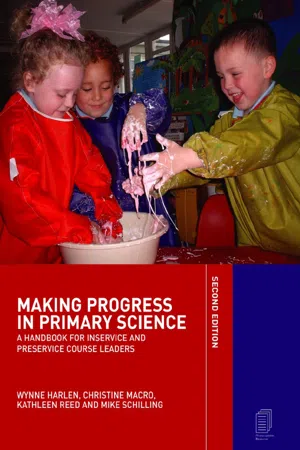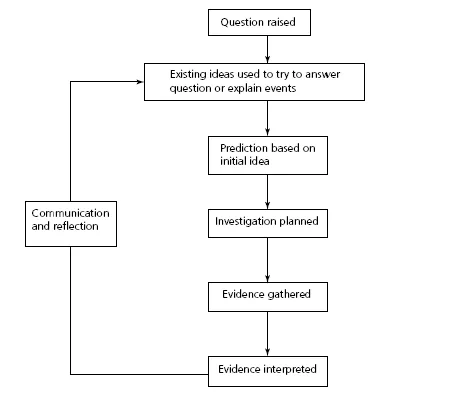
Making Progress in Primary Science
A Study Book for Teachers and Student Teachers
- 256 pages
- English
- ePUB (mobile friendly)
- Available on iOS & Android
Making Progress in Primary Science
A Study Book for Teachers and Student Teachers
About This Book
This new and extensively revised edition of Progress in Primary Science is intended for all those involved in training teachers of primary school science, both preservice and on INSET courses. Its flexible modular structure enables course leaders to tailor their course to participants' needs. Each module can be studied individually or as part of an extended programme and contains notes for facilitators, photocopiable workshop materials, activities for practitioners and suggestions for further reading.
Throughout the book the focus is on the learning of science as an investigative process through which pupils develop an understanding of ideas. This is supported by modules on different aspects of teaching and learning in science, including:
- building on children's own ideas
- how to ask and answer questions
- managing practical work in the classroom
- science for very young children
- effective assessment, self-assessment and feedback
- cross-curricular links
- ICT and science
- science outside the classroom.
The companion study book currently available can be used by those participating on these courses. It follows the same modular structure and contains the same information as this book, and makes planning and delivering the course easier and less time consuming for the course leader.
Frequently asked questions
Information
Module 1 Learning science through enquiry
Starting from children’s ideas
MODULE GOALS
- To give participants direct experience of practical enquiry as a basis for reflection on what it involves.
- To provide a structure, or framework, for thinking about learning through enquiry and identifying the role of process skills in developing ideas.
- To recognise that children often have their own ideas about scientific phenomena prior to school science activities and the implications of this for teaching.
- To identify ways of accessing children’s ideas so that they can be taken into account in teaching.
MODULE OVERVIEW
- sources of green and red light (coloured bulbs or gelatines over torches);
- a ball (tennis ball size) on a stand;
- white screen, matt black screen, or matt black material that can be placed over the screen;
- a location where the ambient light can be minimised (curtains drawn or hung round a table with the equipment set up underneath);
- copies of Activity 1 for those who do not have the Study Book;
- an OHP of the enquiry framework (Figure 1.3).
- copies of Activity 2 and of the two vignettes for those who do not have the Study Book;
- copies of the blank enquiry framework for each pair of participants.
- copies of the activities for those who do not have the Study Book.
INTRODUCTION
- This module is about the key features of learning through enquiry – the process skills and the way in which these are used in developing scientific ideas.
- We start with a practical enquiry in order to have a shared experience to talk about and to recognise what is involved in conducting an enquiry.
- Although we will be considering practical enquiry, not all enquiry is ‘hands-on’ so we will arrive at a meaning of enquiry that includes using evidence from secondary sources – books, CD-ROMs, the Internet, etc.
ACTIVITY 1
- In this case the question was raised for participants (What will the colours be?)
- They used their pre-existing ideas to understand what was going on (ideas about coloured lights recalled and linked to new situation).
- The predictions were based on their ideas about coloured light.
- The test of the predictions was then planned (although in this case there was little detailed planning to do, as the set-up was given).
- Then the evidence was gathered (they made the observations).
- The results were interpreted in terms of the predictions (whether the expected colours were seen) and this also tested the hypotheses on which the predictions were based.
- By discussion and reflection the initial ideas were either changed (if not upheld) or strengthened (if they were upheld).

ACTIVITY 2
- There is a cycle of enquiry, which may be repeated in order to try different ideas (as in the case of Gavin, where the scientific idea of the moisture coming from the air had yet to be tested).
- The essential process/enquiry skills that are used in this enquiry are raising questions, predicting, planning, gathering evidence by observing and measuring, interpreting evidence and drawing conclusions and communicating and reflecting critically. While these can be expressed in different ways – and various terms are sometimes used – they describe the important steps in the enquiry process.
- The ways the skills are used determine the outcome of the enquiry, for example, if the predictions are not tested fairly, then it may be that ideas that should be changed are confirmed. Thus the development of ideas depends crucially on the use of enquiry skills in a scientific manner. (The developmental progression in enquiry skills is discussed in Module 7.)
ACTIVITY 3
- The everyday use of language can easily form misconceptions about the classification of living things – we generally refer to small garden plants as ‘plants’ but refer to trees and bushes by other names, although they are scientifically all plants.
- Children may well have seen rust seemingly emerging from the inside of metal, for example, when painted iron railings become rusted under the paint, which then flakes off to reveal the rust.
- The sensation of ‘seeing’ is of directing our eyes towards what is seen, so it may see...
Table of contents
- Cover Page
- Title Page
- Copyright Page
- Preface
- Acknowledgements
- General notes for facilitators
- Module 1 Learning science through enquiry
- Module 2 The teacher’s role in promoting progress
- Module 3 Teachers’ questions and responses to children’s questions
- Module 4 Managing practical work in the classroom
- Module 5 Science in the early years
- Module 6 Meaning and purposes of assessment
- Module 7 Assessing enquiry skills
- Module 8 Assessing children’s conceptual understanding
- Module 9 Involving children in assessing their work
- Module 10 Providing effective feedback to children
- Module 11 Science and other subjects
- Module 12 Planning for continuity and progression in science activities
- Module 13 ICT and science (1)
- Module 14 ICT and science (2)
- Module 15 The role of external resources in helping children to learn science
- Module 16 Evaluating classroom practice and providing effective feedback to teachers